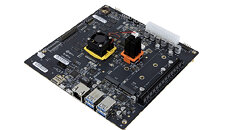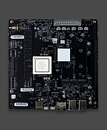Friday, October 30th 2020

RISC-V Comes to PC: SiFive Introduces HiFive Unmatched Development Board
RISC-V architecture is a relatively new Instruction Set Architecture (ISA) developed at the University of California Berkeley. Starting as a "short, three-month project" the RISC-V ISA is a fifth generation of the Reduced Instruction Set Computing (RISC) ideology. A company working on this technology and helping to grow the ecosystem is SiFive. Today, they announced a big step forward for the ecosystem that will enable developers to make and optimize even more software for this architecture and platform. Called the HiFive Unmatched, the development board represents the first entry of RISC-V ISA to the world of personal computing, with its Mini-ITX form factor and PC-like connectors of power supply and I/O.
The board is home to SiFive's FU740 SoC, a five-core heterogeneous, coherent processor with four SiFive U74 cores, and one SiFive S7 core. This SoC is capable of smooth Linux OS operation, giving the developers a good platform to do their optimizations for. There is 8 GB of onboard DDR4 RAM (unknown frequencies and timing), a MicroSD card slot, and one PCIe 3.0 x4 M.2 slot for system storage. To connect the board to the outside world, you get one Gigabit Ethernet port. For user I/O there are four USB 3.2 Gen 1 Type-A ports (1 Charging port) and one MicroUSB Console port. To power the board, you need a proper power supply with a 24-pin power connector. If you plan to build a PC based on the Unmatched board, you would need a standard ITX case, as it comes in the standard Mini-ITX (170x170 mm) form factor. For more information, please check out SiFive's website.
Source:
SiFive
The board is home to SiFive's FU740 SoC, a five-core heterogeneous, coherent processor with four SiFive U74 cores, and one SiFive S7 core. This SoC is capable of smooth Linux OS operation, giving the developers a good platform to do their optimizations for. There is 8 GB of onboard DDR4 RAM (unknown frequencies and timing), a MicroSD card slot, and one PCIe 3.0 x4 M.2 slot for system storage. To connect the board to the outside world, you get one Gigabit Ethernet port. For user I/O there are four USB 3.2 Gen 1 Type-A ports (1 Charging port) and one MicroUSB Console port. To power the board, you need a proper power supply with a 24-pin power connector. If you plan to build a PC based on the Unmatched board, you would need a standard ITX case, as it comes in the standard Mini-ITX (170x170 mm) form factor. For more information, please check out SiFive's website.


12 Comments on RISC-V Comes to PC: SiFive Introduces HiFive Unmatched Development Board
DDR4, PCIE gen 3, m.2, very nice, and relatively modern technologies.
Hopefully it will go much further than this, for real competition, open standards like Risk-V are very good.
You see what happen in the ARM space, and ARM is not really open, but its licensing the instruction set.
We have many big chip producers (Qualcomm, Apple, Samsung, Huawei, MediaTek, Amazon, nVidia, AMD and many others, I'm probably missing some big names anyway)
Thats many more competitors than 2 as for the x86, and this is also one of the reasons for which ARM progressed so fast lately and it will inevitably catch up with x86.
RISC-V isn't supposed to nor able to compete with x86. RISC-V is even more custom than ARM, and lack basic instructions like conditional moves, one of many instructions which greatly improves performance, which x86 have featured since the first Pentium.
RISC-V is relevant for various microcontrollers and specialized CPU designs. WD is using it inside their HDDs, and I believe Nvidia is or will be using it as part of their GPU scheduler.
Intel for some reason always had high power consuming chipsets; with AMD boards (Nforce exception) they did'nt need a full copper based heatsink with heatpipes.
But perhaps with the above we can finally have Risc based computers for daily use. And perhaps support for coreboot as well ( www.coreboot.org/users.html )
What is the purpose of this board? I just don't get the M-ITX form factor and yet it has:
- Removable Storage MicroSD Card
- 1x MicroUSB Console Port
It seems to me to be fusion of old and new. Note the lack of legacy I/O.